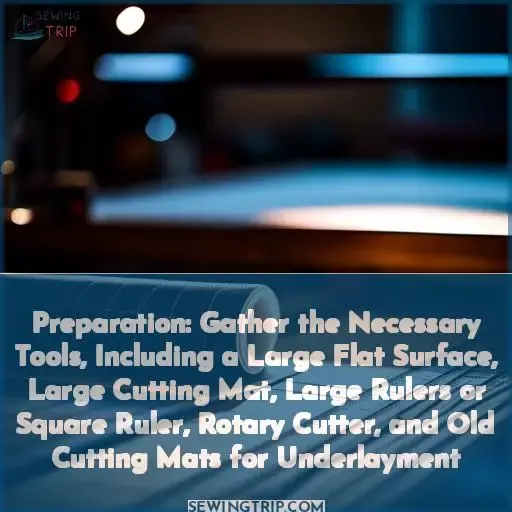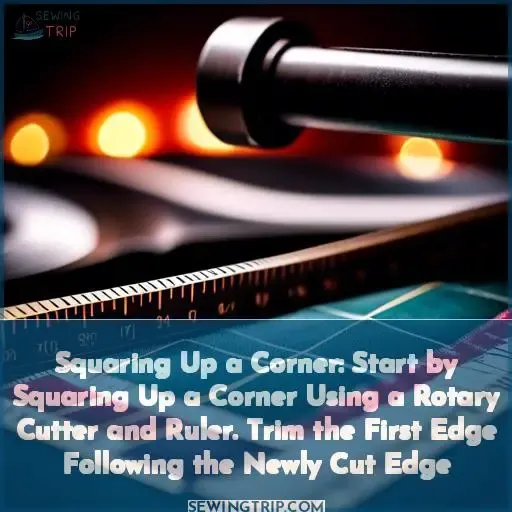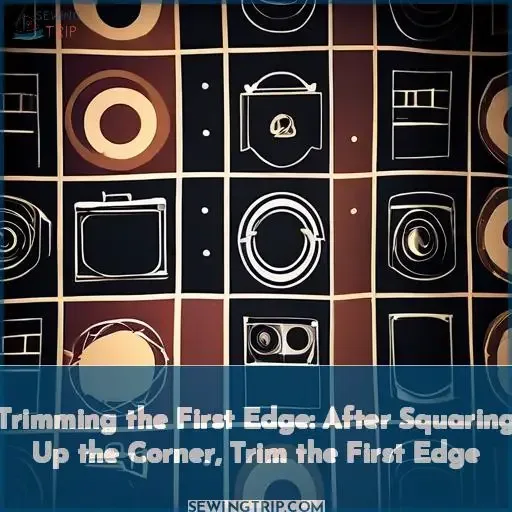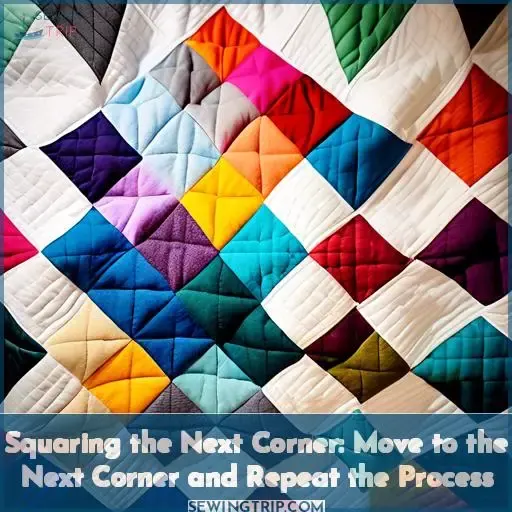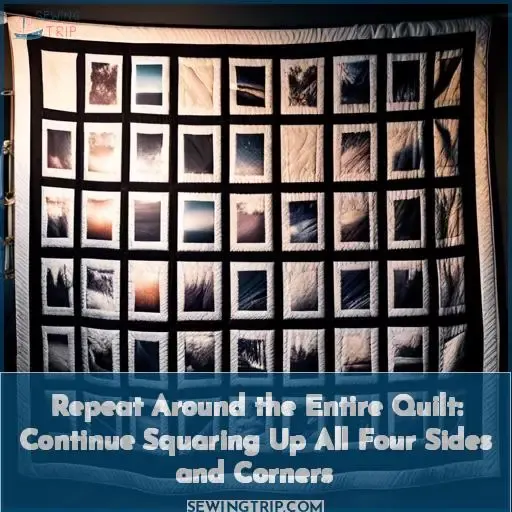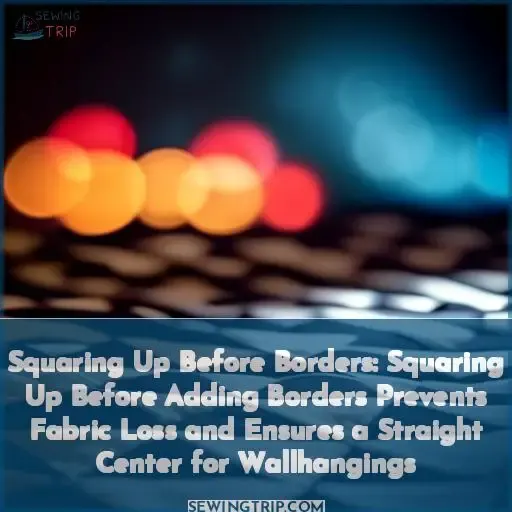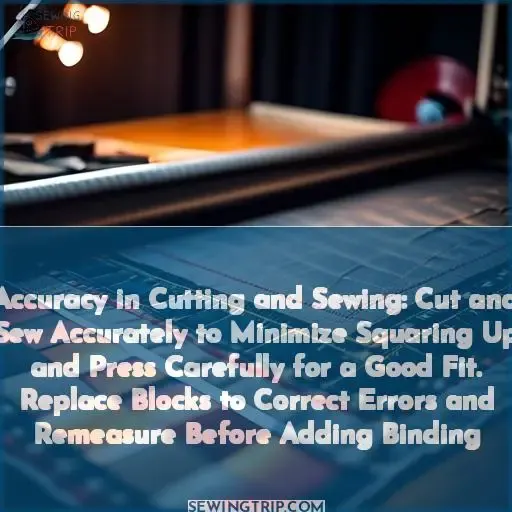This site is supported by our readers. We may earn a commission, at no cost to you, if you purchase through links.
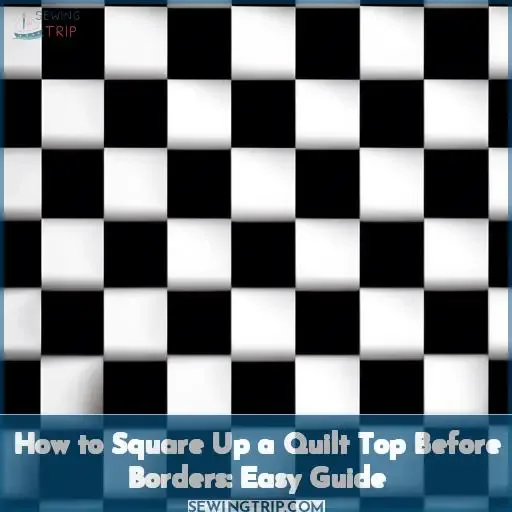 To square up a quilt top before adding borders, follow these steps:
To square up a quilt top before adding borders, follow these steps:
- Gather the necessary tools, including a large flat surface, large cutting mat, large rulers or a square ruler, rotary cutter, and old cutting mats for underlayment.
- Start by squaring up a corner using a rotary cutter and ruler. Trim the first edge following the newly cut edge.
- After squaring up the corner, trim the first edge.
- Move to the next corner and repeat the process.
- Continue squaring up all four sides and corners.
- Be careful when trimming points along the edges to avoid cutting them off.
- Trim points carefully, ensuring a quarter-inch seam allowance.
- Squaring up before borders prevents fabric loss and ensures a straight center for wallhangings.
By following these steps, you can ensure that your quilt top is properly squared up before adding borders, which will help maintain the integrity of your quilt and improve its overall appearance.
Table Of Contents
- Key Takeaways
- How to Square Up a Quilt Top Before Adding Borders ?
- Preparation: Gather the Necessary Tools, Including a Large Flat Surface, Large Cutting Mat, Large Rulers or Square Ruler, Rotary Cutter, and Old Cutting Mats for Underlayment
- Squaring Up a Corner: Start by Squaring Up a Corner Using a Rotary Cutter and Ruler. Trim the First Edge Following the Newly Cut Edge
- Trimming the First Edge: After Squaring Up the Corner, Trim the First Edge
- Squaring the Next Corner: Move to the Next Corner and Repeat the Process
- Repeat Around the Entire Quilt: Continue Squaring Up All Four Sides and Corners
- Special Consideration for Points: Be Careful When Trimming Points Along the Edges to Avoid Cutting Them Off
- Squaring Up Before Borders: Squaring Up Before Adding Borders Prevents Fabric Loss and Ensures a Straight Center for Wallhangings
- Accuracy in Cutting and Sewing: Cut and Sew Accurately to Minimize Squaring Up and Press Carefully for a Good Fit. Replace Blocks to Correct Errors and Remeasure Before Adding Binding
- Frequently Asked Questions (FAQs)
- Conclusion
Key Takeaways
- Gather tools: large flat surface, large cutting mat, large rulers, rotary cutter, old cutting mats
- Square up corners using a rotary cutter and ruler
- Trim with precision to set the standard for the quilt top
- Prevent fabric loss by ensuring a straight center before adding borders
How to Square Up a Quilt Top Before Adding Borders ?
To square up a quilt top before adding borders, ensure all corners are 90-degree angles and edges are straight by trimming after piecing and before attaching borders. This step is crucial to prevent the quilt top from having a wavy appearance and to ensure it lays flat.
Preparation: Gather the Necessary Tools, Including a Large Flat Surface, Large Cutting Mat, Large Rulers or Square Ruler, Rotary Cutter, and Old Cutting Mats for Underlayment
Before you dive into the art of squaring a quilt, let’s gear up with the right tools. Think of yourself as a culinary artist, but instead of knives and pans, your arsenal includes a rotary cutter, a ruler, and a vast cutting mat.
Imagine your workspace as a canvas, where every quilt edge is a stroke of your brush.
First off, secure a large flat surface. This isn’t just any surface; it’s your stage, where all the magic happens. Next, roll out your quilt cutting mat like a red carpet, welcoming your masterpiece. Now, the star of the show: the rotary cutter. Picture it as your wand, ready to make those quilt edges obey with a flick.
And don’t forget the ruler, your trusty sidekick, ensuring every cut is sharp as a tack.
Gathering these tools isn’t just preparation; it’s setting the stage for a flawless performance. As you square a quilt, each slice of the rotary cutter and alignment of the ruler is a step closer to perfection.
Remember, in the grand theater of quilting, precision is the ticket to a standing ovation.
Squaring Up a Corner: Start by Squaring Up a Corner Using a Rotary Cutter and Ruler. Trim the First Edge Following the Newly Cut Edge
To square up a quilt, you’ll need to ensure 90° angles at the corners and straight sides. This step is typically performed after quilting and before binding, trimming excess fabric. Squaring up can be done before quilting for wonky-edged quilts. It’s essential for quilts with straight edges and square corners, as it prevents uneven edges and bubbles during quilting.
It’s recommended before adding borders. Skipping this step can result in a quilt that doesn’t lay flat.
To square up a quilt, you’ll need a large flat surface, a large cutting mat, large rulers or a square ruler, a rotary cutter, and old cutting mats for underlayment. Start by squaring a corner using a rotary cutter and ruler. Trim the first edge following the newly cut edge.
Move to the next corner and repeat the process. Continue squaring up all four sides and corners. Pay special attention to quilts with points along the edges, as trimming carefully is necessary to avoid cutting off points.
Leave a generous quarter-inch seam allowance for points. Start with the points when squaring up these quilts.
Squaring up before borders helps prevent fabric loss and ensures a straight center for wallhangings. It avoids a tilted center. Measure the quilt top at the center and cut borders to that measurement. Ease in differences when sewing on borders. Pin borders carefully for a smooth fit.
Squaring up after quilting checks the quilt top for squareness before adding binding. Trim off excess fabric if necessary. Double-check squareness before adding binding for show quilts.
Accuracy in cutting and sewing minimizes squaring up. Cut and sew accurately to minimize squaring up. Press carefully for a good fit. Replace blocks to correct errors. Small inconsistencies can be corrected during quilting.
When to square up a quilt:
- Square up blocks as you go
- Square up rows as you sew them
- Square up the quilt top before adding borders
- Square up the quilt after quilting
- Square up the quilt before adding binding.
Why square up a quilt:
- Ensures blocks are the same size
- Makes it easier to sew rows and borders
- Prevents distortion in the quilting process
- Creates a more professional-looking quilt
- Reduces the need for excessive trimming.
How to square up a quilt:
- Use a rotary cutter and ruler
- Trim excess fabric from the edges
- Measure the quilt top and make adjustments as needed
- Use a quilting square to check for accuracy
- Press the quilt top to set the new dimensions.
Tips for squaring up a quilt:
- Use a quarter-inch presser foot
- Check seam allowances regularly
- Press seams open to reduce bulk
- Stay-stitch around the quilt top to prevent stretching
- Cut borders using the length of fabric instead of the width.
Benefits of squaring up a quilt:
- Creates a more accurate and consistent quilt
- Reduces frustration and rework
- Saves time and effort in the long run
- Improves the overall quality of the quilt
- Increases the quilt’s value and longevity.
Trimming the First Edge: After Squaring Up the Corner, Trim the First Edge
After squaring up that corner, it’s time to tackle trimming the first edge to perfection. This step is crucial for achieving those straight edges and even corners that make a quilt stand out.
-
Trim with Precision: Grab your trusty rotary cutter and ruler, ensuring you make precise cuts along the edge you just squared up. This attention to detail will set the foundation for a beautifully finished quilt top.
-
Maintain Evenness: As you trim that first edge, keep an eye out for any excess fabric that needs to go. Smooth, even edges are essential for a professional-looking quilt that’s ready for borders.
-
Set the Standard: The way you trim this first edge sets the standard for the rest of your quilt top. Take your time, focus on accuracy, and you’ll be well on your way to a stunning finish that showcases your quilt patterns and keeps those quilt points intact.
With these tips in mind, you’re on your way to mastering the art of trimming that first edge like a pro!
Squaring the Next Corner: Move to the Next Corner and Repeat the Process
When it’s time to square up the next corner of your quilt, you’re on the path to precision and perfection. As you move to the next corner, keep your focus sharp and your tools ready. Align your ruler with the edge, ensuring that 90-degree angle accuracy is maintained.
With a steady hand, trim the excess fabric, following the same method you used for the previous corner. Remember, each corner is a piece of the puzzle that contributes to the overall symmetry of your quilt.
Repeating this process around the entire quilt not only ensures straight sides but also preserves the fabric and maintains a clean finish. Pay special attention to those corners with points; trim carefully to avoid losing those delicate details.
By squaring up each corner meticulously, you’re setting the stage for a beautifully squared quilt top that’s ready for borders.
Repeat Around the Entire Quilt: Continue Squaring Up All Four Sides and Corners
As you continue the journey of squaring up your quilt, it’s time to tackle the task of repeating the process around the entire quilt. This step is crucial for ensuring those perfect edges and square corners that will elevate your quilt to a professional level.
Armed with your trusty rotary cutter and ruler, you’re ready to trim those edges with precision.
Moving from corner to corner, you’ll find a rhythm in this repetitive yet rewarding process. With each trim, you’re not just shaping fabric; you’re crafting a masterpiece. Pay attention to ruler measurements, ensuring every cut is spot on.
As you work your way around, the quilt borders will start to take shape, aligning perfectly with your vision.
Stay focused on maintaining that quarter-inch seam allowance and follow those quilt tips diligently. This continuous cut strip around the quilt will bring you one step closer to a beautifully squared-up masterpiece that’s ready for the next stage of quilting magic.
Special Consideration for Points: Be Careful When Trimming Points Along the Edges to Avoid Cutting Them Off
When squaring up your quilt top before adding borders, it’s crucial to trim points along the edges with care to avoid cutting them off. Ensure you leave a generous quarter-inch seam allowance for these points to maintain the integrity of your design.
Trimming Points Carefully
To trim points carefully, pay attention to quilts with points along the edges. Start with the points when squaring up these quilts.
Trim carefully to avoid cutting off points. Leave a generous quarter-inch seam allowance for points.
If you’re dealing with wonky edges, use precision cutting techniques. Measurement and square are crucial for trimming points effectively.
Quarter-inch Seam Allowance
To ensure the accuracy and professionalism of your quilt, it’s crucial to pay attention to the quarter-inch seam allowance when trimming points along the edges.
- Trim Carefully: Be meticulous when trimming points to avoid cutting them off.
- Quarter-inch Seam Allowance: Always leave a generous quarter-inch seam allowance for points.
- Squaring Up Before Borders: Squaring up before adding borders is essential to prevent fabric loss and ensure a straight center for wallhangings.
- Accuracy in Quilting: Cut and sew accurately to minimize squaring up and press carefully for a good fit. Replace blocks to correct errors and remeasure before adding binding.
Squaring Up Before Borders
Before you dive into adding borders, squaring up your quilt top is like laying the groundwork for a masterpiece.
Think of your ruler as your trusty sidekick, guiding you through each corner with precision.
Trimming those edges isn’t just about keeping things tidy; it’s about setting the stage for quilt binding that sits just right.
And remember, when dealing with points, a generous seam allowance is your best friend. This step ensures your quilt doesn’t just look good; it feels right, laying the foundation for a border that aligns like a dream.
Squaring Up Before Borders: Squaring Up Before Adding Borders Prevents Fabric Loss and Ensures a Straight Center for Wallhangings
Squaring up before adding borders to your quilt is a crucial step that ensures precision and a polished finish.
- Measuring Borders: Before attaching borders, measure your quilt top at the center accurately. This step sets the foundation for perfectly fitting borders.
- Trimming Excess Fabric: Trimming off any excess fabric before adding borders not only enhances the appearance but also makes the sewing process smoother.
- Using Large Cutting Mat: Utilize a large cutting mat to provide ample space for precise cutting and aligning your borders seamlessly.
When you square up your quilt before adding borders, you’re not just preventing fabric loss; you’re setting the stage for a quilt that lays flat, with a straight center ideal for wall hangings. This attention to detail ensures that your quilt looks professional and well-crafted, enhancing its overall quality and longevity.
Accuracy in Cutting and Sewing: Cut and Sew Accurately to Minimize Squaring Up and Press Carefully for a Good Fit. Replace Blocks to Correct Errors and Remeasure Before Adding Binding
When it comes to quilting, accuracy and precision in cutting and sewing are key to minimizing the need for excessive squaring up. To achieve a professional finish, it’s crucial to cut and sew with care, ensuring your quilt pieces fit together seamlessly.
- Cutting with Precision: Take your time to cut fabric pieces accurately, following the measurements meticulously to avoid errors.
- Sewing with Care: Seam by seam, sew with precision to maintain the correct dimensions and prevent the need for extensive adjustments later on.
- Error Correction: If you notice any mistakes in your blocks or seams, don’t hesitate to replace them promptly to maintain the overall accuracy of your quilt.
By focusing on accuracy in cutting and sewing, you’ll not only save time and effort but also ensure a smooth quilting process with minimal rework. Remember, a little extra attention to detail during this stage can go a long way in creating a beautifully finished quilt.
Frequently Asked Questions (FAQs)
Can squaring up be done before quilting?
Yes, squaring up can be done before quilting. Some quilters choose to square up their quilt top before quilting, especially if they’re working with wonky-edged or improv quilt designs. This allows them to correct any distortion that may occur during the quilting process.
What tools are needed for squaring up a quilt?
To square up a quilt top before adding borders, you’ll need a few essential tools. These include a rotary cutter, cutting mat, and a square ruler. The rotary cutter and cutting mat are used to trim excess fabric from the edges of the quilt, while the square ruler helps ensure that the corners and sides are straight and at a 90-degree angle.
It’s important to use a square ruler, as it will help maintain the accuracy of the squaring process. Additionally, a large flat surface, such as a table or floor, is necessary for laying out and working on the quilt.
When squaring up a quilt, follow these steps:
- Lay the quilt out on a large flat surface, such as a table or the floor.
- Use a rotary cutter and cutting mat to trim the excess fabric from the edges of the quilt, following the lines of the square ruler.
- Square each corner by lining up the square ruler with the edge of the quilt and trimming the excess fabric.
- Repeat the process for all four sides and corners, ensuring that the quilt top is now square.
Remember to pay special attention to points along the edges of the quilt, as they can be easily cut off if not handled carefully. It’s recommended to leave a generous quarter-inch seam allowance for points to avoid accidental trimming.
Squaring up a quilt before adding borders is essential for several reasons. It prevents fabric loss from borders, ensures a straight center for wallhangings, and avoids a tilted center. It also makes the quilt easier to handle and sew, as the straight edges and corners make it easier to align borders and sew them on accurately.
In summary, to square up a quilt top before adding borders, you’ll need a rotary cutter, cutting mat, and a square ruler. Follow the steps outlined above to ensure that your quilt top is square and ready for border addition.
How to square up a quilt without losing points?
To square up a quilt top before adding borders without losing points, follow these steps:
-
Square up the corners: Use a rotary cutter and ruler to square up each corner of the quilt top. Start with one corner, line up the ruler, adjust it gently for a square corner, and cut. Repeat for the other three corners.
-
Trim the edges: After squaring up the corners, trim the long edges of the quilt top. Use a large ruler and rotary cutter to cut along the newly squared edges, stopping before reaching the end of the ruler to avoid cutting into the quilt.
-
Square the points: Be careful when squaring up quilts with points along the edges. Trim carefully to avoid cutting off points. Leave a generous quarter-inch seam allowance for points, and start with the points when squaring up these quilts.
-
Measure and cut borders: Measure the quilt top at the center and cut borders to that measurement. Ease in differences when sewing on borders, pin borders carefully for a smooth fit, and cut borders to match the quilt top after pinning.
-
Press borders: Press borders after sewing to ensure they lie flat.
By following these steps, you can square up a quilt top before adding borders without losing points.
What is the best order to square up a quilt?
To square up a quilt before adding borders, follow these steps:
- Start by squaring a corner using a rotary cutter and ruler.
- Trim the first edge following the newly cut edge.
- Square the next corner using the same method.
- Repeat the process for all four sides and corners.
Remember to pay close attention to quilts with points along the edges and trim carefully to avoid cutting off points. Leave a generous quarter-inch seam allowance for points and start with the points when squaring up these quilts.
Can squaring up be skipped for certain quilts?
Yes, squaring up can be skipped for quilts with irregular edges or wonky shapes. However, for quilts with straight edges and square corners, it’s essential to ensure a flat, professional finish.
Conclusion
To ensure your quilt top is properly squared up before adding borders, follow these steps:
- Gather necessary tools.
- Square up corners.
- Trim edges.
- Be careful with points.
Squaring up before borders prevents fabric loss and ensures a straight center. Cut and sew accurately, press carefully, and replace blocks if needed. By doing so, you’ll maintain the integrity of your quilt and improve its appearance.

